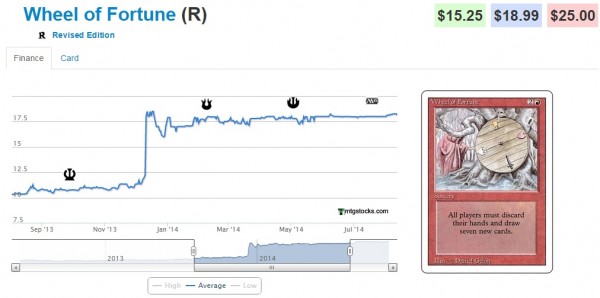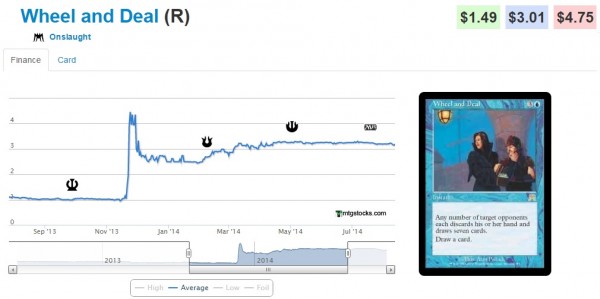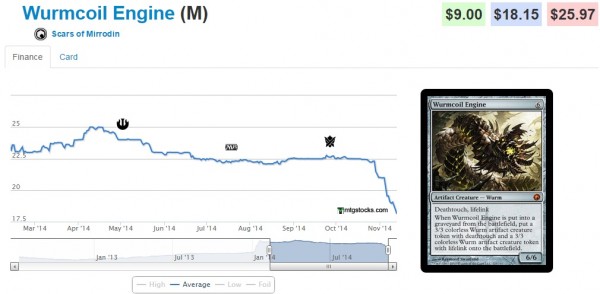Are you a Quiet Speculation member?
If not, now is a perfect time to join up! Our powerful tools, breaking-news analysis, and exclusive Discord channel will make sure you stay up to date and ahead of the curve.
Welcome back, readers! The sentiment from my fellow writers this week appears to be a bit more dour than I'd prefer, so lets try and find some good out of the Commander 2014 printings.
Sure, they reprinted some oddball cards that many of us didn't expect:
- Wurmcoil Engine
- Goblin Welder
- Black Sun's Zenith
- Grave Titan
- Crypt Ghast
But just as importantly there were some cards we thought might show up and didn't. This list includes
- Damnation
- Linvala, Keeper of Silence
- Phyrexian Obliterator
- Elesh Norn, Grand Cenobite
- Sheoldred, Whispering One
- Doubling Season
- Oracle of Mul Daya
- Vorinclex, Voice of Hunger
- Vampiric Tutor
- Demonic Tutor
- Enlightened Tutor
- Worldly Tutor
- Sylvan Tutor
With the exception of the first four, the value for the remainder of the cards all comes from the EDH market. These are the types of cards that can easily find a home in any commander deck of the appropriate color and yet they didn't show up. So the sky isn't exactly falling on MTG finance/speculation. Sure if you had a pile of Wurmcoil's in your spec box you took a pretty big hit, but it could have been a whole lot worse.
Lessons to Learn
1. Diversify - There's a reason that stock brokers tend to harp on this concept. By keeping your portfolio diverse you don't take as big of a hit when one stock does poorly (or in our case when a card gets reprinted and plunges in value).
2. Nothing is safe - With the exception of the reserved list, every card in Magic is reprintable by Wizards of the Coast. They are in the business to make money and if reprinting a few cards will help sell a set or product they would be smart to do so. This also means that we, as speculators, can not longer view reprintable cards as "safe investments". With the shift by WoTC to do away with Core sets and increase the number of "blocks" per year, we will see even more cards reprinted than ever before.
3. Magic cards aren't like stocks - They aren't regulated by any official source (outside of WoTC), their supply is controlled completely by one source (discounting fakes obviously), and that source is a business that makes money off of them, and will act according to this interest.
4. WoTC is pushing Commander - With the release of the third set of Commander decks (and it looking to be a yearly thing from now on), WoTC clearly understands that the EDH crowd is a hungry market that will buy a good amount of product. This implies that cards whose demand derives mostly from Commander players have a higher likelihood of being reprinted.
5. WoTC isn't afraid of putting Eternal-minded cards into the Commander product. However, at least with this past round they did tone it down from the likes of True-Name Nemesis (a four-of maindeck powerhouse) to something like Containment Priest (a one- to three-of sideboard card).
Applying the Lessons
The next question is what to do with what we've learned.
As with any investment strategy, we must remain flexible. While it's always smart to have a goal with your investments, it's not wise to remain so attached to that goal that you end up suffering losses or missing other opportunities simply by remaining rigid.
Reprints will happen. As stated, unless it's on the Reserved List it can be reprinted and if it will sell product, you can expect it to. This means that going deep on any particular spec carries greater risk than previously thought. (I say this because in all actuality WoTC has always had the ability to reprint cards it was just that we as speculators/buyers/sellers expected them to hold back more).
New Legacy cards will likely continue to show up in supplemental product as a way to help sell it. The benefit of this is that the other cards in the deck will often end up "deflated" in price as Eternal players buy the sealed product, take their one card and try to unload the others.
If you want a great example, look at the price of Nekusar, the Mindrazer--one of the most popular generals from the last block of commander product. His existence caused spikes across the board in Wheel of Fortune effects...and yet he himself can be picked up for less than $1.
Cards linked to a specific plane, character or story line are not safe from reprint simply because they don't "fit the theme" of any particular Commander deck. Neither are cards with set-specific keywords (like Extort on Crypt Ghast).
Just because some cards in a cycle show up does not mean that the whole cycle will. In theory one could have learned this from any of the previous commander releases. 2011 saw Austere Command as the sole Command reprinted, 2013 saw just Inferno Titan from the Titan cycle and Blue Sun's Zenith from the Zenith cycle.
However, we do know WoTC likes to complete cycles, and in 2014 we got Sun/Grave/Frost Titan from that cycle (given Primeval's ban) to finish the Titan cycle as well as Black Sun's Zenith and White Sun's Zenith (leaving Green and Red as the only outstanding Zeniths not included in a Commander product).
Many speculators expected WoTC to use the Commander product as a way to re-introduce additional copies of expensive Modern cards to the format. While the reprinting of Wurmcoil has likely tanked the price, we expected more cards like it. The fact that WoTC didn't include them does imply that they are concerned with tanking card values too quickly (even at the cost of extra product sales), which is a good sign for us.
Commander 2014 was the first Commander product to add new planeswalkers. While they have occasionally reprinted existing ones (Garruk Wildspeaker in 2011) this is the first instance in which they created new ones just for the product.
I wouldn't be surprised if we see this trend continue (though it's less likely that they'll do one per deck). It's also important to note that with the exception of Daretti, all the new ones were five or more mana, implying that WoTC won't have too much trouble keeping any new ones powerful as they'll just slap a high CMC on them to keep them out of the eternal spotlight.
WoTC is trying to keep the product more balanced to prevent another Mindseize problem (in which stores were selling out of Mindseize's but other decks were left to rot on the shelves). The easiest solution to this is to make sure that either all of them are desirable or none of them are--obviously only the former makes fiscal sense.
It would be extremely challenging to predict what the playerbase would view as "balanced", so the play by WoTC was to make sure that they didn't have too much value in any one particular deck. (The red one is currently selling above MSRP, but I expect that with Wurmcoil's price continuing to drop it will eventually reach an equilibrium point).
Grand Prix New Jersey
I will be at GP New Jersey (I actually fly out tonight) so if anyone runs into me, definitely say hello and introduce yourself. I love talking to people about MTG and finance.








Question.
With the shift by WoTC to do away with Core sets and increase the number of “blocks” per year, we will see even more cards reprinted than ever before.
What makes you think this is true? Part of the reason for going to the new block structure is because they were running out of ideas in the old one by the third set. This+cutting a set that is 50% reprints would imply to me at least that the # of reprints printed in normal sets will be going down, not up.
My thought process on that comment was that the new change will have more cards enter/rotate out of standard per year, thus, more total cards will be printed.